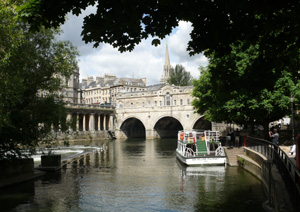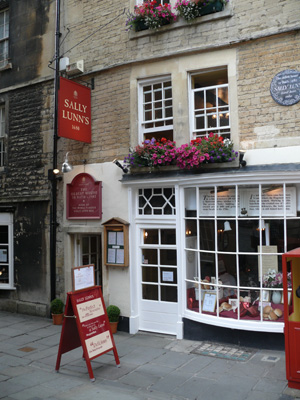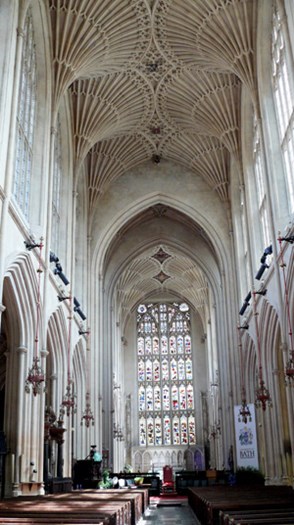BATH, ENGLAND – It’s graduation day and the banks of the River Avon are crowded with caps and gowns and the students wearing them jockey for position as parents and friends snap photographs of the momentous moment.
The University of Bath grads want one last memory of their time in this, the loveliest of English cities; one more photograph of the city’s handsome honeycomb skyline dominated by grand Georgian homes and majestic churches, some built over 2,000 years ago with limestone dug out of the city’s quarry.
Tears well up in eyes – it’s hard to say goodbye to classmates and this magnificent UNESCO World Heritage city with the rich Roman history.
The favourite spot along the Riverwalk for photographs appears to be a place where the Avon flows under the 18th century Pulteney Bridge, which was completed in 1774. It’s here where the river, bridge and grouping of historic buildings and church spires – plus, on this summer’s day a powder blue sky punctuated with cotton ball clouds – come together to form a spectacular moment in time.


Left: The lovely River Avon flows through Bath. Right: Quaint shops selling sweets dominate the old town.
From atop the handsome stone bridge – Bath’s version of Florence’s famed Ponte Vecchio, complete with shops – congratulatory words rain down on the students from mates and passersby.
The grads are being rushed because their convocation ceremony is about to begin in Bath’s stunning abbey, which dates back to 1499 and is the last great medieval church standing in England.
We follow them on the short walk to reach the square where the great abbey stands – an area where three churches have stood over time, including an Anglo-Saxon abbey, circa 757AD.
The abbey’s ornate wooden doors are wide open and we are afforded a look at the majesty within. Light streaming through vast stained glass windows bathes parishioners in a rainbow of colours and our eyes are quickly drawn heavenward by the brilliance of the abbey’s fan-vaulted ceiling. The abbey is indeed an awesome sight and one of the most impressive religious structures we’ve ever seen.
The small square is where Bath’s dynamic history intersects. On either side of the great abbey stands reminders of Bath’s former eras – the Roman baths on one side and on the other a grouping of Georgian apartments built to house the aristocrats who came here in the 18th century to enjoy the therapeutic powers the city’s hot mineral baths offered.


Left: Bath has returned to its spa roots with a modern new facility. Right: Bath Cathedral is stunning.
Legend has it the hot springs that gush to the surface in three different spots in Bath were first discovered by Bladud, father of Shakespeare’s King Lear, in 500BC and the local Celts then dedicated them to the their god, Sul.
The Romans followed in 43AD and during their long stay created exotic public baths for the enjoyment of Caesar’s legions. One reason the Romans liked Bath so much, besides the constant warm-running water, is that the city has seven hills, just like Rome.
The original baths were demolished by later generations and used in construction projects of the day. What you see in Bath now is a recreation of the original Roman baths.
A local woman tells us it takes about 10,000 years for the rain water that soaks into Bath’s lovely landscape to return the surface. Every day a quarter of a million gallons of steaming hot water, at a constant temperature of 46.5C, bubbles up.
A museum set up in the Roman baths – the place where the original water source can still be seen - showcases what archeologists uncovered over the centuries and an interpretation of what life was like during that period keeps the thousands of tourists that come here each day spellbound. The Pump House connected to the baths is now one of the city’s more desirable eating spots.
Bath’s first renaissance occurred between 1692 and 1703, when Queen Anne came to take the waters. That set in motion regular visits by generations of royals – London and its royal palaces, after all, are only an hour and a half away by rail - and the development of “modern” Bath and its grand Georgian homes began.
The most famous of Bath’s houses is a collection of stunning Georgian townhomes called the Royal Crescent and the Circus, both built in the mid-1700s. The Royal Crescent and Circus still remain the most desirable addresses in Bath and are counted among the city’s 5,000 listed buildings. Some of the stately townhomes have been converted into chic boutique hotels – the Royal Crescent Hotel is tops among them but a close second is the Queensberry.
During the 18th and 19th centuries, Bath became a cultural haven, attracting such literary giants as Jane Austen – a museum has now been created in the home she once lived around the corner from the Royal Crescent – and Charles Dickens, as well as artist Thomas Gainsborough and poet William Wordsworth.
A meningitis scare in the mid 20th century, thought to be caused by the hot mineral water but later proven wrong, shut down the public baths for a long time and decay quickly followed. Then, as part of a huge millennium project, the ultra-modern Thermea Spa – the best public facility on the planet in this writer’s opinion – was created, incorporating some of the ancient spa buildings in its chic glass and steel design. After many delays, the Thermea Spa opened in 2006 and Bath’s second renaissance was in full swing. Now the city is once again the centre of attention with foreign and local tourists.
But Bath is far more than history and hot springs. It’s actually turned into one of England’s better known shopping cities, with chic designer shops setting up in the central area of Bath around the much-visited Roman spas. A pedestrian mall on Stall Street just outside the historic baths leads to a wonderful collection of retail shops and restaurants.
A new shopping area set up opposite the city’s quaint railway station and constructed with the same golden Bath stone as its historic neighbours, is also a welcome addition to the city’s shopping scene, as is an area between Milsom Street and Broad Street, known as Milsom Place. The boutique shops there are London-worthy.
Although it’s a steep climb to reach the Royal Crescent, the Circus and some of the city’s more memorable museums – Bath boasts more the 24 major museums, by the way – walking around this handsome city with the elevated sidewalks is still the best way to see it.
And when it comes to dining, few places on the planet can offer the variety and quality restaurants Bath does. One thing you quickly realize, though, is that while the Romans are long gone, their cuisine remains and is featured here in the best collection of Italian eateries outside Rome.
But for something really special, a visit to Sally Nunn’s Tea Room on charming Lilliput Alley behind the abbey is a must.
The building in which the narrow three-storey restaurant is located is the oldest home standing in Bath, dating back to 1482, and remains the most popular eating establishment in the city, mainly because of Sally Nunn’s buns.
“I’m not her (Sally), you know,” says a wisecracking woman named Maureen, who mans a small museum in the restaurant’s basement and tells visitors the story of the young woman from France who arrived in Bath in 1680 and turned the city on its ear with her baking skills.
Maureen is being kept busy this day as the graduating students arrive with their families in tow so they, too, can savor the restaurant’s excellent cuisine and tantalizing history.
“Sally was an expert in French brioche-type bread, or buns as they were later called, and they became a very popular part in two of Bath’s revered traditions – breakfast and afternoon tea,” explains Maureen, who sits surrounded by artifacts found during archeological digs beneath the property, where a building has stood through every period of Bath’s history, including Roman and Saxon times.
“Sally’s name was really Solange Luyon, you know, but the British anglicized it to Sally Lunn,” says the elderly Maureen, who directs our attention to a replica of Sally’s tiny kitchen opposite her station.
“The recipe for Sally’s buns was actually lost for many years but was rediscovered in the 1930s in a secret cupboard over the downstairs corner fireplace,” says Maureen, who encourages us to return to the main floor and “sample the buns for yourself.”
The buns we order come topped with a steak and mushroom sauce and one bite confirms that these are the best buns we’ve ever tasted – a real treat, just like Bath.
10 Places You Must Visit in Bath:
1. The Roman baths
2. Sally Lunn’s Tea Room
3. Thermae Spa
4. Guidhall market
5. The Royal Crescent
6. The Pump Room
7. The Guildhall
8. Pulteney Bridge
9. Bath Abbey
10. Riverwalk